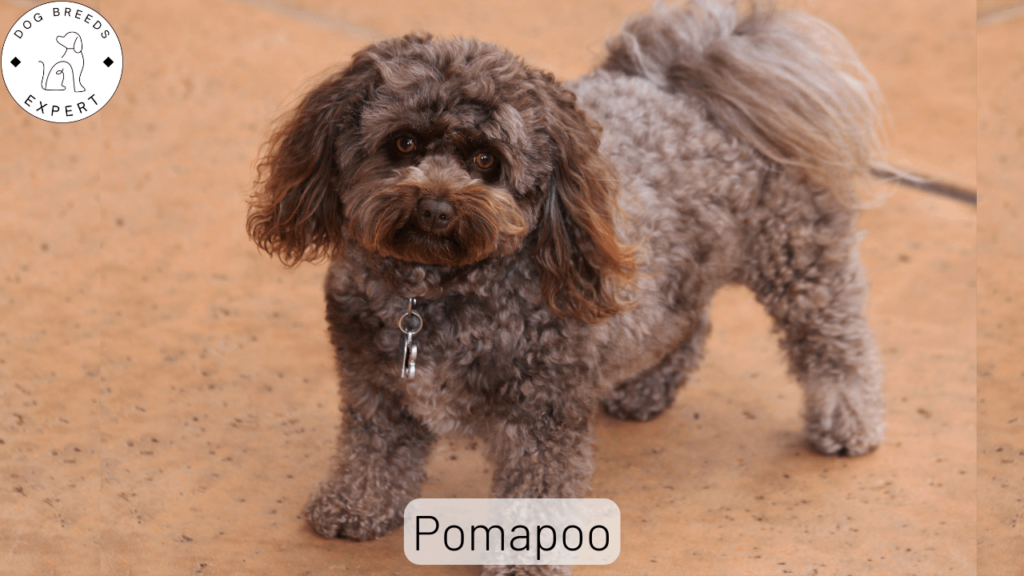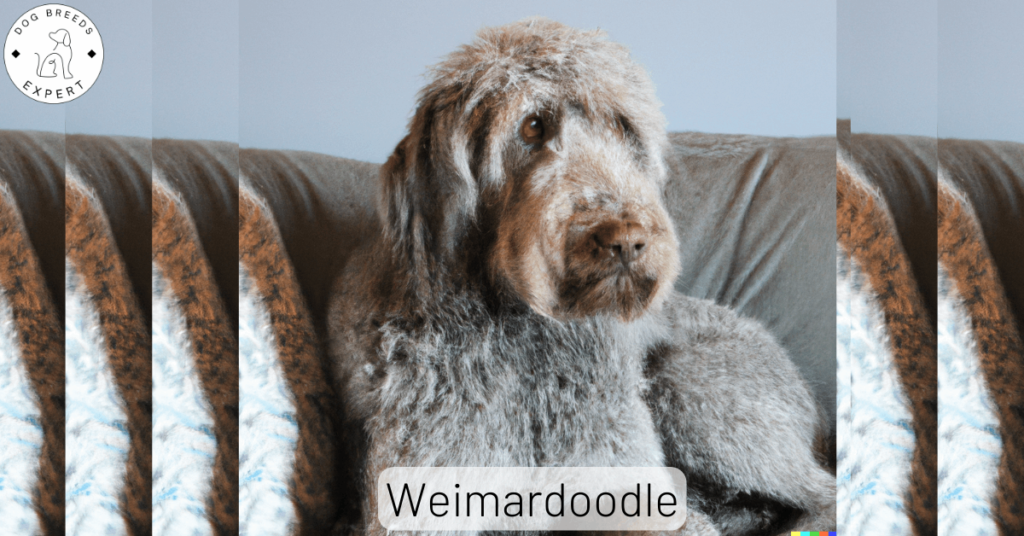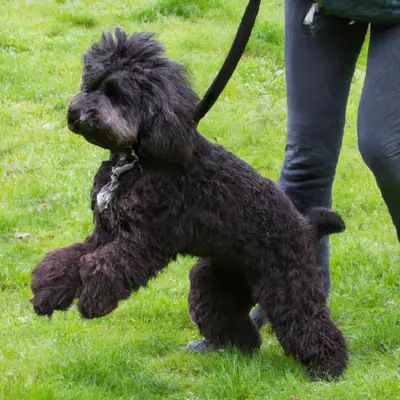
The Rottle is a cross between a Rottweiler and a Poodle that combines the best traits of both purebred parents. They are known for their intelligence, loyalty, protective nature, friendly temperament, and affectionate personalities. The Rottle is a great family dog and is an excellent companion for children and adults.
This hybrid breed with a muscular build and a dense coat, also known as Rottiepoo, Rottidoodle, is a relatively new breed that has been gaining popularity among dog owners in recent years.
| Parent Breeds | Rottweiler & Poodle |
| First Cross Date | 1980s |
| Average Height | 12-27 inches |
| Average Weight | 27-40 kg (60-90 lbs) |
| Life Span | 9-15 Years |
| Colors | Black, Brown, Tan, Cream, Silver, apricot |
| Popular Names | Rottle, Rottweiler Poodle Mix, Rotttiepoo, Rottiedoodle |
| Temperament | Playful, Friendly, Caring, Intelligent, Protective |
| Coat Texture | Curly or Wavy |
| Temperature Tolerance | (Any weather) Sensitive to extreme temperatures |
| Sheading Nature | Year-round (Moderate) |
| Energy Level | Moderate |
| Social/Attention Needs | Moderate |
| Grooming Frequency | Monthly |
This blog post will explore the Rottle breed in more detail, including their temperament, characteristics, and care requirements. We will also discuss their history and how to find a reputable Rottle breeder if you want to add one of these loving dogs to your family.
Rottle Breed Overview
- Rottle is a designer breed, a mix of Rottweiler and Poodle, also known as Rottie-Poo.
- The first known crossing occurred in the 1880s in the United States.
- They are medium to large-sized dogs, weighing between 60 and 110 pounds and standing 22 to 27 inches tall.
- Their appearance and coat colors can vary significantly due to the diverse genetic pool of their parent breeds.
- Rottweiler and poodle mix are friendly, affectionate, and intelligent, making them great family pets.
- Early socialization and training are essential to managing their guarding instincts and potential stubbornness.
- Regular grooming is needed to maintain their coat, brushing at least twice weekly.
- They require daily exercise and mental stimulation to stay fit and happy.
- Rotttiepoos can be prone to health issues such as hip dysplasia, progressive retinal atrophy, heart issues, and bloat.
- Proper socialization, training, and consistent care are crucial for a happy, healthy pet.
Rottle Parent Breeds History
Rottweiler
The Rottweiler is a large breed of dog known for its strength, intelligence, and robustness. The breed’s history dates back to ancient Roman times when it was primarily used as a herding and guarding dog.

Originating in the town of Rottweil in southwestern Germany, the Rottweiler is believed to have descended from Roman drover dogs. These dogs were brought to the region by the Roman legions as they expanded their empire. The canines were used to herd and guard livestock, particularly cattle, as the legions moved through Europe.
As the Roman Empire declined, the Rottweiler’s ancestors continued to work as herding dogs in the Rottweil region. They were highly valued for their working ability and protective instincts. The town of Rottweil became an important trade center during the Middle Ages, and these dogs played a crucial role in safeguarding livestock and goods from theft.
They were initially called “Rottweil butchers’ dogs” or “Rottweil Metzgerhund” in German. By the late 1800s, the Rottweiler was facing the threat of extinction.
Fortunately, enthusiasts in Germany started working towards preserving the breed in the early 20th century. The Allgemeiner Deutscher Rottweiler Klub (ADRK) was established in 1907 to oversee the breed’s standard and development.
The breed gained popularity in other countries, including the United States, where the American Kennel Club (AKC) registered the first Rottweiler in 1931.
The Rottweiler is a popular breed worldwide for its versatility and adaptability. While they still excel as herding and guarding dogs, they are also widely used in various roles such as search and rescue, police and military work, service and therapy dogs, and as loyal family pets. Their intelligence, loyalty, and protective instincts have made them a favored breed among dog enthusiasts.
Poodle
The Poodle has captivated people for generations with its extraordinary physical prowess and sharp intellect. Initially bred for aquatic retrieval tasks, this refined breed has become a beloved companion.
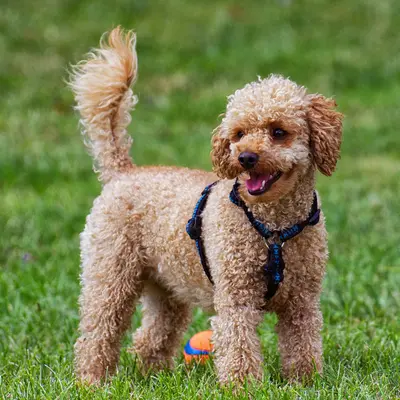
The Poodle’s enchanting qualities were first captured in the 1400s by the renowned German artist Albrecht Dürer. As the breed’s fame spread during the 16th and 17th centuries, its enthralling features continued to captivate admirers.
The Poodle’s versatility and adaptability have been showcased in various settings, from dog shows to therapeutic environments, as it gained widespread recognition as a cherished family companion. The breed’s hypoallergenic coat and affable disposition have endeared it to dog lovers around the globe.
Between the 16th and 17th centuries, the Poodle’s association with European nobility cemented its status as an emblem of sophistication. The breed’s charm flourished in the United States from the 19th to the early 20th century.
In 1887, the American Kennel Club (AKC) officially acknowledged the Poodle, further solidifying its enduring presence in canine companionship.
Rottle History & Origin
The exact origin of the Rottle is not well-documented. Historians believe that this designer dog breed may have existed naturally over decades. However, the intentional breeding of this hybrid puppy started in the 1880s in North America.
Rottle gained popularity in the late 19th and early 20th century.
The Rottle aims to cross the purebred parents to develop a versatile, intelligent, and friendly dog. As a mixed breed, the Rottiedoodle can exhibit a wide range of characteristics, depending on the traits inherited from each parent.
Their size can vary from medium to large, and their coat can be curly like a Poodle or shorter and denser like a Rottweiler. Their hypoallergenic coat makes them suitable for people with allergies.
Vital Stats

- Average Weight: 27-40 kg (60-90 lbs)
- Average Height: 12-27 inches
- Average Lifespan: 9-15 years
- Breed Group: Mixed dog breed
Physical Characteristics
The Rottle is a medium to large-sized dog, typically weighing 27-40 kg (60-90 lbs) and standing 12 to 27 inches tall. Their appearance can vary due to the diverse genetic pool of their parent breeds. Rottweiler Poodle Mix can have a lean or muscular build, with short to medium-length wavy or curly hair.
Their coat colors range from black, brown, and tan to cream, silver, and apricot. The Rottle’s eyes are usually dark brown, and its muzzle is typically broad and square-shaped.
Temperament and Personality
The Rottle is known for its friendly, affectionate, and intelligent nature. With proper socialization and training, these mix breed dogs can be fantastic family pets that get along well with children and other animals.
They tend to be protective of their families, making them excellent watchdogs. However, it’s important to note that their Rottweiler heritage can lead to stubbornness and a strong guarding instinct, so early training is essential to manage these traits.
Care and Grooming
The Rotttiepoo’s coat requires regular grooming to keep it tangle-free and healthy. Brushing their coat at least twice a week is recommended, with more frequent brushing during shedding seasons.
Bathing can be done as needed, typically every 6-8 weeks, depending on the dog’s activity level.
Regular exercise is crucial for a Rottle, as energetic canines need physical and mental stimulation. Daily walks, interactive play sessions, and obedience training can help keep them fit and happy.
Socialization is also important from an early age to help your furry friend develop a well-rounded temperament.
Health Concerns
The Rottle is generally healthy. However, they may be prone to specific health issues inherited from their parent breeds. Common health concerns include hip dysplasia, progressive retinal atrophy, heart issues, and bloat.
Regular veterinary check-ups, a balanced diet, and a healthy weight can help prevent or manage these conditions.
Pros & Cons of Owning Rottle
Pros
- Rottles inherit intelligence from Rottweiler and Poodle’s parents, making them highly trainable and eager to learn.
- They are known for their loyalty and affection towards their family, making them excellent companions.
- They can excel in various activities, including agility, obedience, tracking, and therapy work, due to their intelligence and athleticism.
- These mixed breed dogs can be gentle and patient with children when properly socialized and trained, making them suitable family pets.
- Rottiedoodles can adapt to different living environments, including apartments if their exercise and mental stimulation needs are met.
- Depending on their coat type, they may have low to moderate shedding, which can benefit those with allergies or who prefer less dog hair around the home.
Cons
- Rottles have high energy levels and require daily exercise and mental stimulation to prevent boredom and destructive behaviors.
- As a mixed breed, Rottles can be prone to specific health issues inherited from their parent breeds, such as hip dysplasia and eye problems.
- Depending on their coat type, these large dog breeds may require regular grooming to prevent matting, shedding, and skin issues.
- They can be medium to large-sized dogs, which may not be suitable for all living situations or households.
- Rottle puppy require consistent training and early socialization to develop into well-behaved, well-adjusted dog.
- They may inherit noise sensitivity from their Poodle parent, making them more prone to anxiety or stress in loud or chaotic environments.
Health Requirements
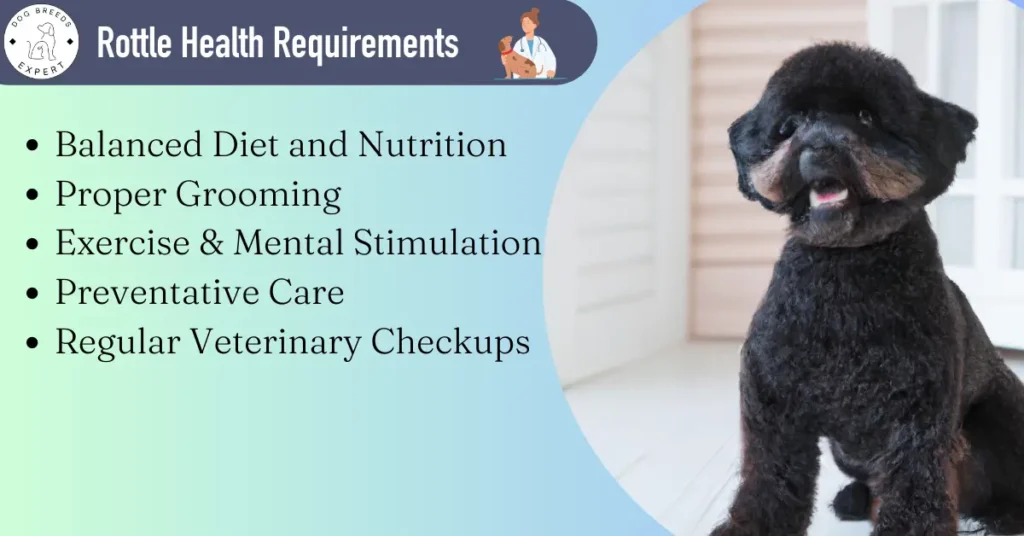
1) Balanced Nutrition
Providing a balanced diet is crucial for Rottles. This breed may be prone to obesity, so it’s essential to feed them high-quality dog food formulated for their age, size, and activity level. Avoid overfeeding, and consider consulting your veterinarian for specific dietary recommendations.
2) Exercise & Mental Stimulation
Rottles are energetic and intelligent dogs, requiring regular physical exercise and mental stimulation to stay healthy and happy. Aim for at least 30-60 minutes of exercise daily, including walks, playtime, and agility training.
Providing puzzle toys, obedience training, or scent work can help keep their minds engaged.
3) Dental Care
Dental health is crucial for rottie doodle, as they can be prone to dental issues like gum disease and tartar buildup. Regular teeth brushing (2-3 times per week) with dog-specific toothpaste can help maintain good oral hygiene.
Consider providing dental chews and scheduling professional dental cleanings as needed.
4) Grooming
Rotttiepoos can inherit different coat types, ranging from short and dense to curly and thick. Regular grooming helps remove loose hair, prevents matting, and keeps skin healthy. Brush your pup’s coat at least once a week and bathe them every 4-6 weeks or as needed.
Trim their nails regularly and check their ears for signs of infection or debris.
5) Preventative Care
Rottles can be prone to specific genetic health issues, such as hip dysplasia, elbow dysplasia, and eye disorders. Regular screening and early detection can help manage these conditions. Moreover, ensure your puppy receives routine vaccinations, heartworm prevention, and flea/tick control to minimize the risk of common health problems.
6) Regular Veterinary Checkups
Rottiedoodles should have routine veterinary checkups at least once a year. These visits can help identify potential health issues early on and ensure your dog is up to date on vaccinations and parasite prevention. As these hybird dogs ages, more frequent checkups may be necessary.
Diet Requirements
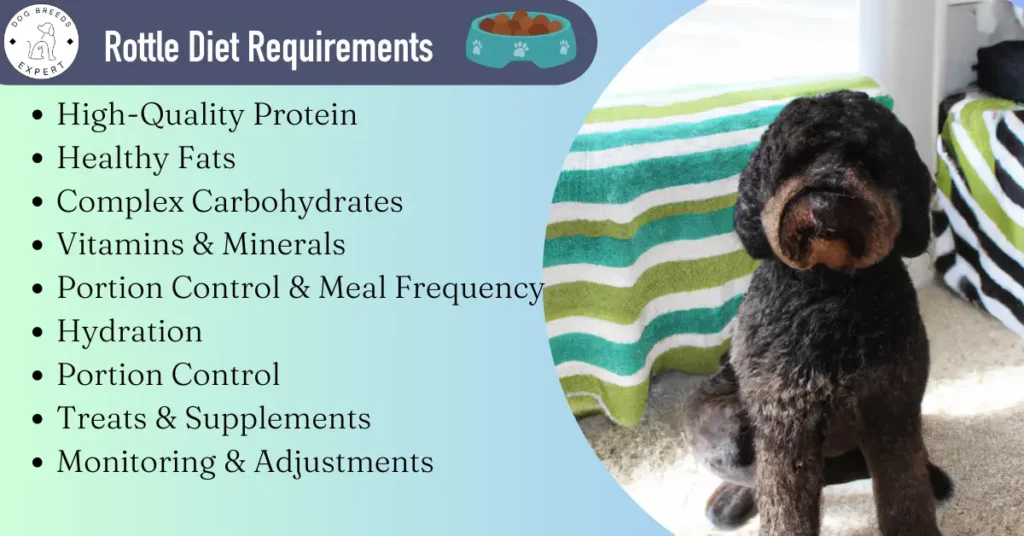
1) High-Quality Dog Food
Select a high-quality commercial dog food formulated for your pet’s age, size, and activity level. Look for brands that use whole, natural ingredients and avoid those containing artificial additives or fillers.
Consult your veterinarian for recommendations based on your dog’s specific needs.
2) Balanced Macronutrients
Rottweiler Poodle Mix require a diet that appropriately balances proteins, fats, and carbohydrates.
- Protein: They need high-quality protein sources, such as chicken, turkey, beef, fish, or lamb. Protein should comprise around 18-25% of their diet, supporting muscle growth and repair.
- Fats: Healthy fats like omega-3 and omega-6 fatty acids are essential for skin and coat health, brain function, and immune system support. Fats should make up around 10-15% of their diet. Sources can include fish oil, flaxseed, and chicken fat.
- Carbohydrates: Carbohydrates provide energy and should come from wholesome, easily digestible sources like sweet potatoes, brown rice, or barley. Avoid feeding your Rottle excessive amounts of carbohydrates or low-quality sources, which can lead to obesity and digestive issues.
3) Vitamins & Minerals
A well-balanced diet should include essential vitamins and minerals that support overall health, bone development, and immune system function. High-quality commercial dog food typically contains these nutrients, but if you choose to feed a homemade diet, consult your veterinarian for guidance on supplementation.
4) Portion Control & Meal Frequency
To prevent overfeeding and obesity, controlling portion sizes and meal frequency is essential.
- Puppies: Rottle puppies should be fed 3-4 tiny daily meals to support their rapid growth and development.
- Adults: Adult dogs typically do well with 2 meals daily, split evenly between morning and evening.
- Seniors: Older Rottles may require adjustments to their diet, such as reduced calorie intake or increased fiber, based on their activity level and overall health.
Always follow the feeding guidelines provided by your dog food manufacturer or consult your veterinarian for personalized recommendations.
5) Treats & Snacks
While treats can be essential for training and positive reinforcement, they should be given in moderation. Opt for healthy, low-calorie treats like small pieces of lean meat or vegetables and ensure that treats do not exceed 10% of your pet’s daily caloric intake.
6) Hydration
Fresh water should always be available to your furry friend. Encourage regular hydration by providing clean water in a suitable bowl and changing it frequently.
7) Monitoring & Adjustments
Regularly monitor your Rotttiepoo’s weight, body condition, and overall health. Adjust their diet and exercise routine to maintain a healthy weight and prevent obesity-related health issues.
Grooming Requirements

1) Regular Brushing
Brush your Rottle’s coat at least once a week to remove loose hair, prevent matting, and distribute natural oils throughout the coat. The frequency of brushing may vary depending on the coat type:
- Short and dense coats: Use a slicker brush or a grooming mitt to remove loose hair and keep the coat healthy.
- Curly and thick coats: Use a pin brush or a slicker brush to detangle and remove loose hair and a metal comb for finishing.
2) Bathing
Bathe your canine pet every 4-6 weeks or as needed, depending on their coat type, lifestyle, and level of dirtiness. Use a mild, dog-specific shampoo to maintain the natural oils in their skin and coat.
Ensure to rinse thoroughly to remove all shampoo residue, as leftover shampoo can cause skin irritation.
3) Nail Trimming
Trim your pooch’s nails regularly every 3-4 weeks to prevent overgrowth and potential injuries. Use a dog nail clipper or grinder and be cautious not to cut the quick (the blood vessel inside the nail), as it can be painful and cause bleeding.
4) Ears Care
Check your Rottle’s ears weekly for signs of infection, debris, or excessive wax buildup. Use a dog specific ears cleaning solution and cotton balls or gauze to gently clean the outer ear canal.
Avoid using cotton swabs, as they can damage the inner ear structures. If you notice foul odors, discharge, or redness, consult your veterinarian for further evaluation.
5) Dental Care
Dental health is essential for mixed breed dogs, as they can be prone to dental issues like gum disease and tartar buildup. Brush your Rottiedoodle’s teeth 2-3 times per week using dog-specific toothpaste and a soft-bristle toothbrush.
Regular teeth brushing can help your pet maintain good oral hygiene, freshen breath, and prevent dental problems. Consider providing dental chews and scheduling professional dental cleanings as needed.
6) Coat Clipping & Trimming
If your pooch has a long, curly coat like a Poodle, they may require regular coat clipping and trimming to keep their fur manageable and neat. Trim your pooch coat every 6-8 weeks, depending on the desired length and style.
You can either learn to groom yourpet at home or take them to a professional groomer.
7) Regular Inspections
While grooming your furry friend, inspect their body for any signs of skin issues, parasites, or unusual lumps and bumps. Addressing potential issues early on can help prevent complications and ensure your dog’s overall well-being.
Training Requirements
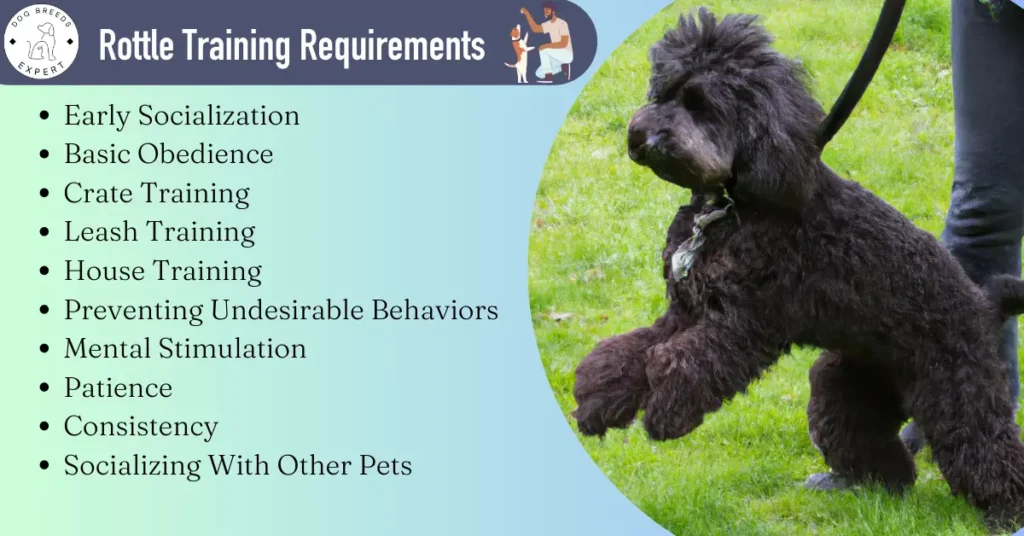
1) Early Socialization
Begin socializing your Rottle early to expose them to various environments, people, animals, and situations. This helps them become more adaptable, confident, and less likely to develop anxiety or aggression.
Puppy socialization classes, visits to dog-friendly locations, and meeting friends and family members can contribute to proper socialization.
2) Basic Obedience Training
Teach your Rottle basic obedience commands, such as sit, stay, come, down, and heel. This helps establish a strong foundation for good behavior and communication between you and your dog.
Consistent training with clear commands and positive reinforcement techniques, like praise and treats, is crucial for success.
3) Crate Training
Crate training is helpful for preventing destructive behavior when unsupervised. Introduce your pet to the crate gradually, using positive reinforcement to make it a comfortable and enjoyable space. Remember, crates should never be used as a punishment.
4) Housebreaking
Start housebreaking your canine as soon as possible. Consistency and routine are vital factors in successful housebreaking. Establish a regular schedule for feeding, playtime, and potty breaks.
Take your Rotttiepoo outside to the designated elimination area and reward them with praise and treats for successful elimination.
5) Leash Training
Leash training ensures that your furry friend walks politely on a leash without pulling or lunging. Begin by introducing your dog to the collar and leash in a controlled environment.
Gradually increase the duration and complexity of your walks, reinforcing good behavior with praise and treats.
6) Preventing Undesirable Behaviors
Train your Rottle to avoid jumping, excessive barking, and chewing. Address these behaviors by providing appropriate outlets for energy and reinforcing desirable behaviors.
For example, redirect your dog’s attention to a toy when they start chewing on something inappropriate.
7) Advanced Training & Mental Stimulation
Rottles are intelligent and can benefit from advanced training, such as agility, tracking, or obedience competitions. These activities provide mental stimulation and help maintain a strong bond between you and your dog.
Consider providing puzzle toys and interactive games to engage their minds.
8) Consistency & Patience
Training a pet dog requires consistency and patience. Use clear commands and positive reinforcement and maintain a regular training schedule. Avoid punishment-based techniques, as they can damage your relationship with your dog and result in fear or aggression.
9) Socializing With Other Pets
If you have other pets, introduce your pooch gradually, allowing them to get acquainted in a controlled and neutral environment. Supervise interactions and reward positive behavior for encouraging harmonious relationships between your pets.
Common Rottle Health Issues
- Hip dysplasia
- Elbow dysplasia
- Bloat (Gastric torsion)
- Progressive Retinal Atrophy (PRA)
- Cataracts
- Obesity
- Allergies
- Ear infections
- Hypothyroidism
- Addison’s disease
How To Find A Reputable Rottle Breeder.
Finding a reputable Rottle breeder is crucial to ensure you get a healthy, well-adjusted puppy from responsible breeding practices. Here are some steps to help you find a reputable Rottle breeder:
- Start by researching breeders online, in local directories, or through breed-specific forums and social media groups. Gather information about their reputation, breeding practices, and experiences of previous customers.
- Ask for referrals from veterinarians, dog trainers, or friends and family members who have had positive experiences with breeders.
- Contact breed clubs or organizations for Rottweilers and Poodles, as they may have lists of recommended breeders or can guide finding a reputable breeder.
- Arrange a visit to the breeder’s facility to assess the dogs’ cleanliness, living conditions, and overall well-being. A reputable breeder will happily show you where the dogs live and answer any questions.
- A responsible breeder will prioritize the health and temperament of their breeding dogs, perform relevant health tests, and avoid breeding dogs with known genetic issues.
- Meeting the puppy’s parents can give you an idea of their temperament, size, and appearance, providing insight into your future Rottle’s characteristics.
- A reputable breeder will provide health guarantees, vaccination records, and documentation for genetic testing and health clearances for the parent dogs.
- Check if the breeder starts early socialization and exposes the puppies to various environments, people, and experiences.
- Reputable breeders often have waitlists for their puppies and may require a deposit. They should have a fair and transparent deposit policy and refund process.
- A good breeder will be interested in their puppies’ well-being even after leaving for their new homes. They should be willing to provide support, advice, and guidance as needed throughout the dog’s life.
Rottle Mixed Breed Dog Pictures






FAQ
Yes, Rottles can get along well with other pets when socialized and introduced gradually. However, individual temperaments and experiences may vary.
Yes, Rottles can make good family pets due to their loyalty, affection, and intelligence. They can be gentle and patient with children when appropriately socialized and trained.
Yes, Rottles can protect their family due to their Rottweiler heritage. This trait, combined with their intelligence, makes them good watchdogs. However, proper socialization and training are essential to prevent overprotectiveness or aggression.
Rottles do not typically bark excessively. However, individual dogs may bark more due to boredom, anxiety, or lack of mental stimulation. Consistent training and providing sufficient exercise can help minimize excessive barking.
My Final Thoughts
The Rottle is a unique and versatile breed that has captured the hearts of many dog lovers. Its friendly disposition, intelligence, and loyalty make it an excellent family pet. If you consider adding a Rottle to your family, provide proper socialization, training, and consistent care to ensure a happy, healthy, and well-adjusted companion.


